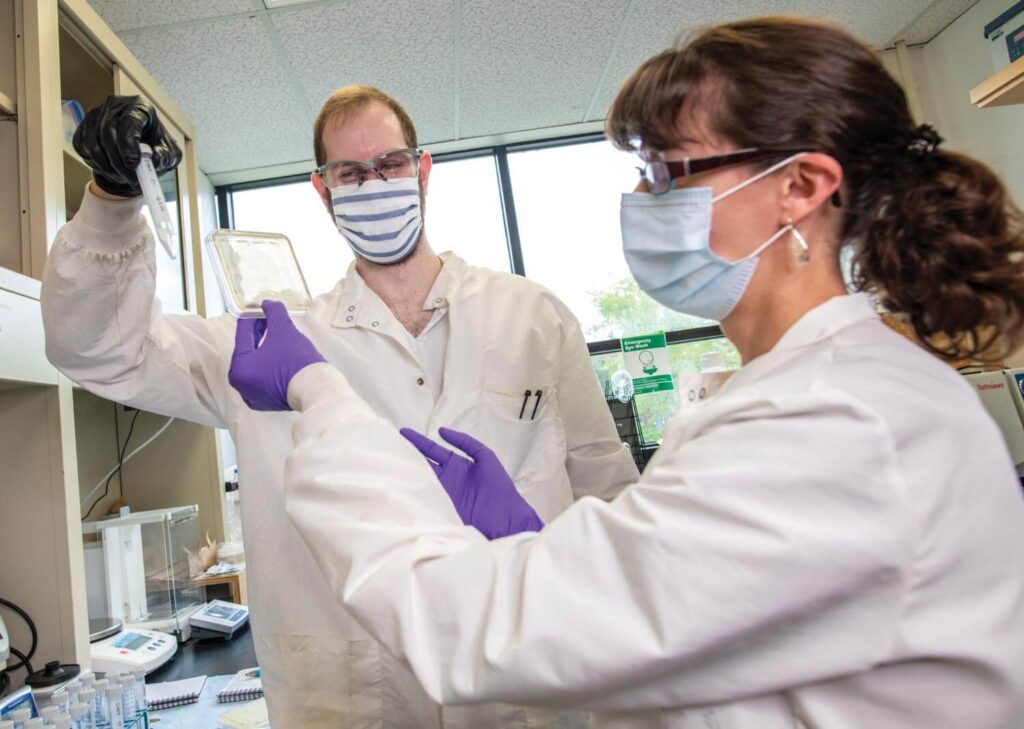South American glaciers
The history of South America’s retreating glaciers at the end of the last ice age is the focus of a three-year National Science Foundation study led by the University of Maine.
Brenda Hall, UMaine professor of glacial geology in the School of Earth and Climate Sciences and the Climate Change Institute, will lead the team of scientists and student researchers. Their work, funded by a more than $510,000 NSF grant, will help clarify the timing of the last ice age termination in the Southern Hemisphere and the forces behind it by studying the glaciers in the Cordillera Darwin. The ice field is located in the southern tip of South America.

Delving deeper into the last ice age termination, the largest natural warming event in recent geological history, could provide more context for understanding rising global temperatures today and improve future climate predictions.
Research team members include UMaine professor George Denton and assistant professor Aaron Putnam, both with the School of Earth and Climate Sciences and the Climate Change Institute; associate professor Joellen Russell, an Earth-system modeler from the University of Arizona, and professor Patricio Moreno, a paleoecologist from the University of Chile. UMaine students and a student from the Medill School of Journalism at Northwestern University also will join the field team.
Bee appeal
 A natural way to support Maine’s wild blueberry industry is to cultivate plants popular with bees, such as butterfly weed, starflower, summer sweet, sweet clover and swamp rose, according to a University of Maine study.
A natural way to support Maine’s wild blueberry industry is to cultivate plants popular with bees, such as butterfly weed, starflower, summer sweet, sweet clover and swamp rose, according to a University of Maine study.
Recent declines in wild native bee populations have garnered global attention, particularly in Maine where blueberry growers depend on bees to pollinate their crops. While bumblebees (Bombus spp.) are recognized as the most effective pollinators of wild blueberries, Maine growers are increasingly relying on Apis mellifera, a non-native bee, to pollinate their fields. Establishing bee reservoirs to provide forage when the blueberries are not in bloom is one strategy that could benefit Maine’s native bumblebees while sustaining an economically important agricultural industry.
To ensure that bee reservoirs are effective, UMaine assistant research professor Alison Dibble led a four-year study to assess the appeal of plantings to native and other bees. The study, conducted in collaboration with UMaine researchers Frank Drummond and Lois Stack, measured the relative attractiveness of nearly 90 species of annuals, perennials and shrubs. The research results are published in a UMaine Cooperative Extension bulletin, “Selecting Plants to Support Bees in Maine: Summary of the Bee Module Project.”
$4.8M for FBRI facilities
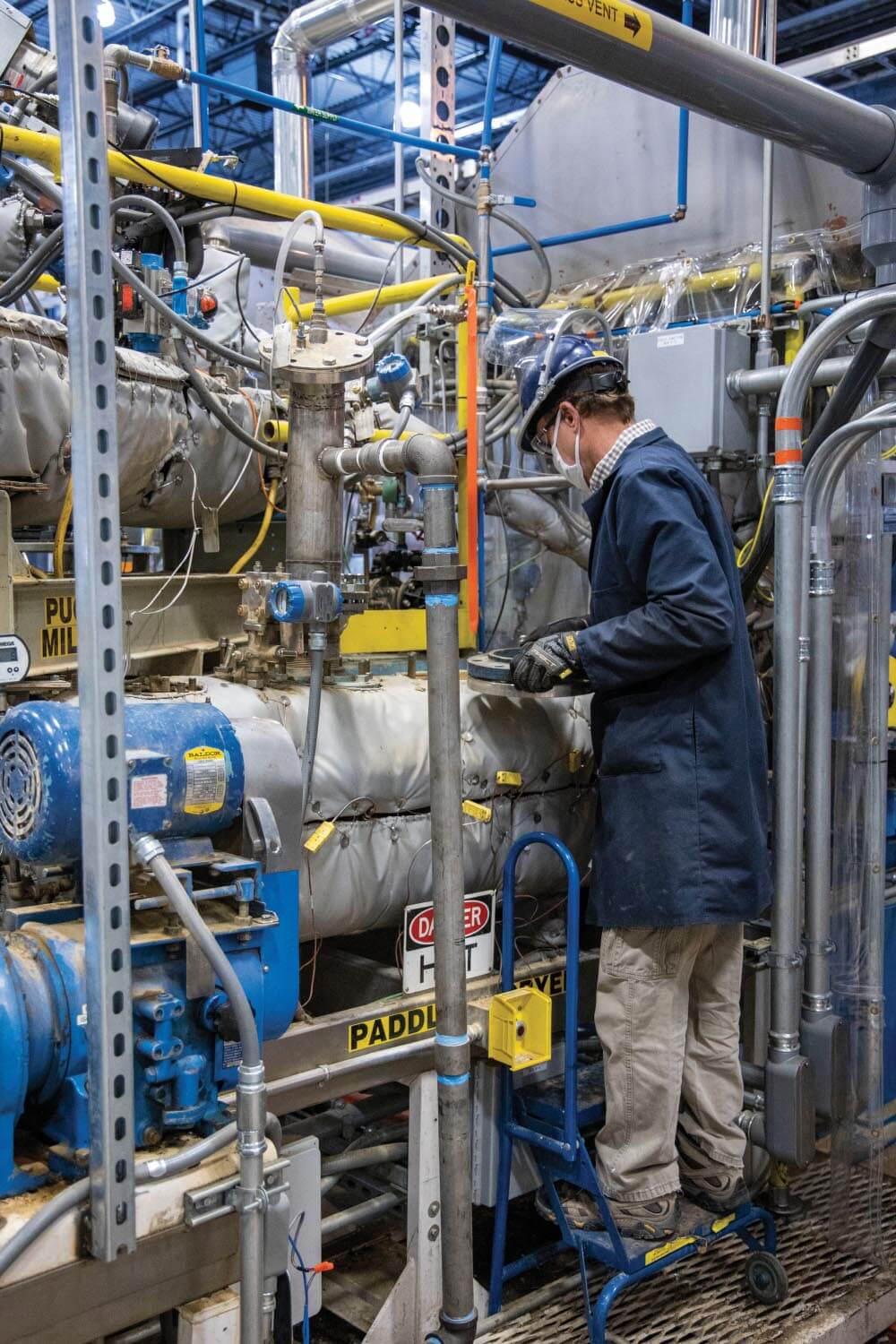 The University of Maine Forest Bioproducts Research Institute (FBRI) will upgrade its Technology Research Center (TRC) in Old Town and Process Development Center (PDC) in Jenness Hall to bolster ongoing efforts to create new bioproducts, increase production and find uses for woody biomass materials typically considered waste.
The University of Maine Forest Bioproducts Research Institute (FBRI) will upgrade its Technology Research Center (TRC) in Old Town and Process Development Center (PDC) in Jenness Hall to bolster ongoing efforts to create new bioproducts, increase production and find uses for woody biomass materials typically considered waste.
Defense Logistics Agency awarded $4.8 million for FBRI research in crafting renewable fuel, heating oil, chemicals, plastics and other goods from woody biomass at a large scale. Institute director Hemant Pendse says his team will invest about $2 million in processing technology infrastructure improvements for the off-campus TRC facility, as well as the on-campus PDC facility, with the balance supporting ongoing research.
Equipment added to TRC, located on the pulp mill site in Old Town, will help researchers process biochar, charcoal derived from the pyrolysis of wood, as well as preprocess biomass. Upgrades at PDC will boost nanocellulose production.
“It’s a significant upgrade in our pilot-scale infrastructure,” says Pendse, also a chemical engineering professor. “This significant investment will allow us to rapidly advance development in several major areas of ongoing research.”
New equipment at PDC will allow the production of nano-fibrillated cellulose starting with wood chips or sawdust particles. The new tools also will help FBRI create a variety of chemicals, liquid fuels and nanocellulose materials from woody biomass such as sawdust, and assess the prospects for beneficial uses of biochar, which is typically viewed as a waste byproduct.
Freshwater equity
Anne Lausier and Shaleen Jain say a reevaluation and refocusing of the ways that water resources are managed are urgently needed. Equity should be a foundational tenet of management, they say, especially today when there are unprecedented pressures on Earth’s freshwater resources and ecosystems. Toward that goal, Lausier and Jain put forth a Water Resources Stewardship framework, published in the journal Water Security, that includes six interlinking elements to comprehensively evaluate water management. Their invited article based on their research titled “Water resources stewardship: Changes, extremes, and equity,” was posted in Global Water Forum, a United Nations global portal for water-related issues and knowledge.
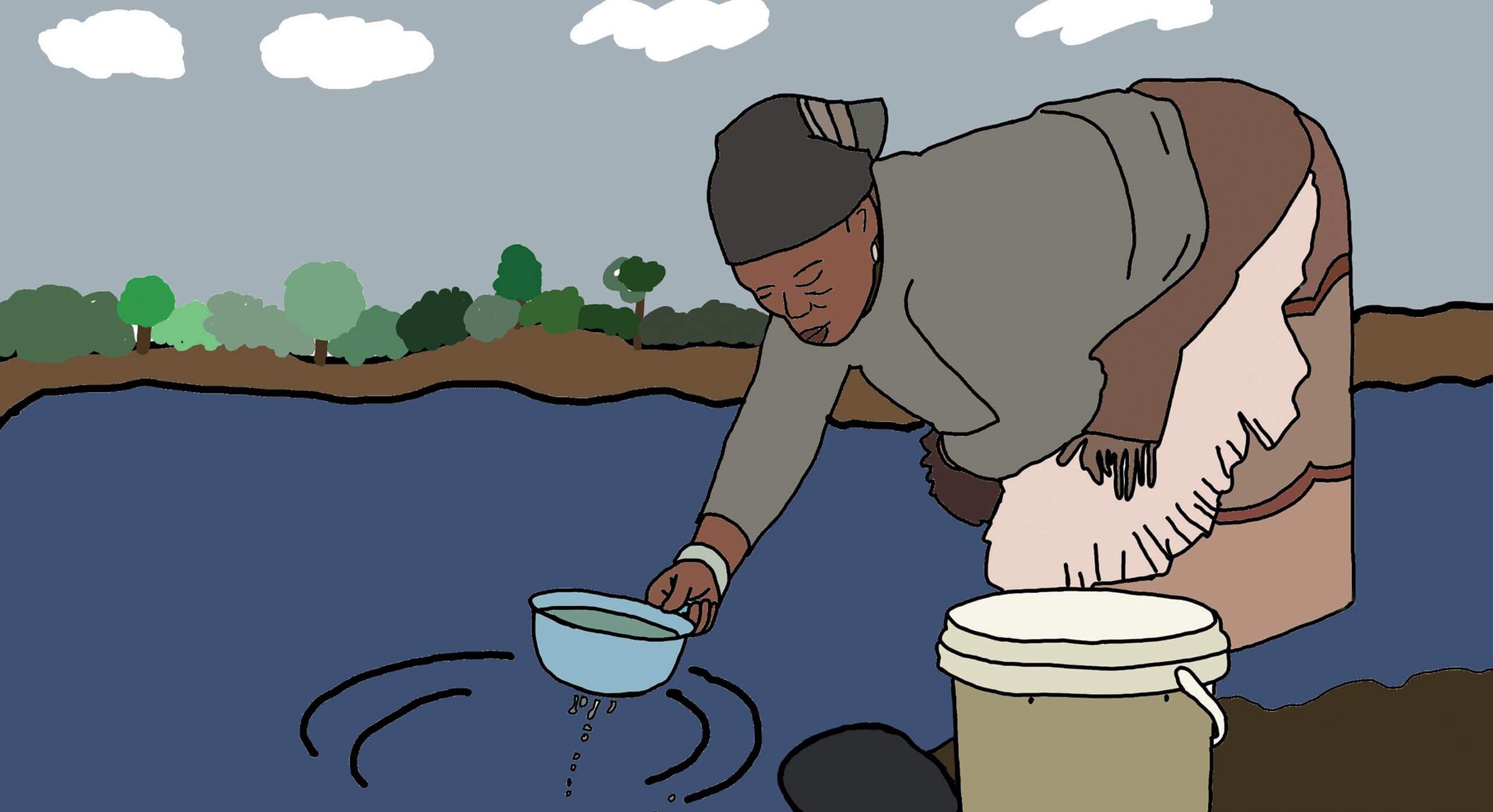
Lausier conducted the research when she was a civil engineering doctoral student and a U.S. National Science Foundation Graduate Research Fellow at the University of Maine. She is now a physical scientist at the Office of Ground Water and Drinking Water with the U.S. Environmental Protection Agency.
She and Jain, a UMaine professor of civil and environmental engineering, say they view water resources stewardship as a societal imperative that demands carefully devised solutions toward “our shared human responsibility for the environment under changing conditions.”
Troop protection
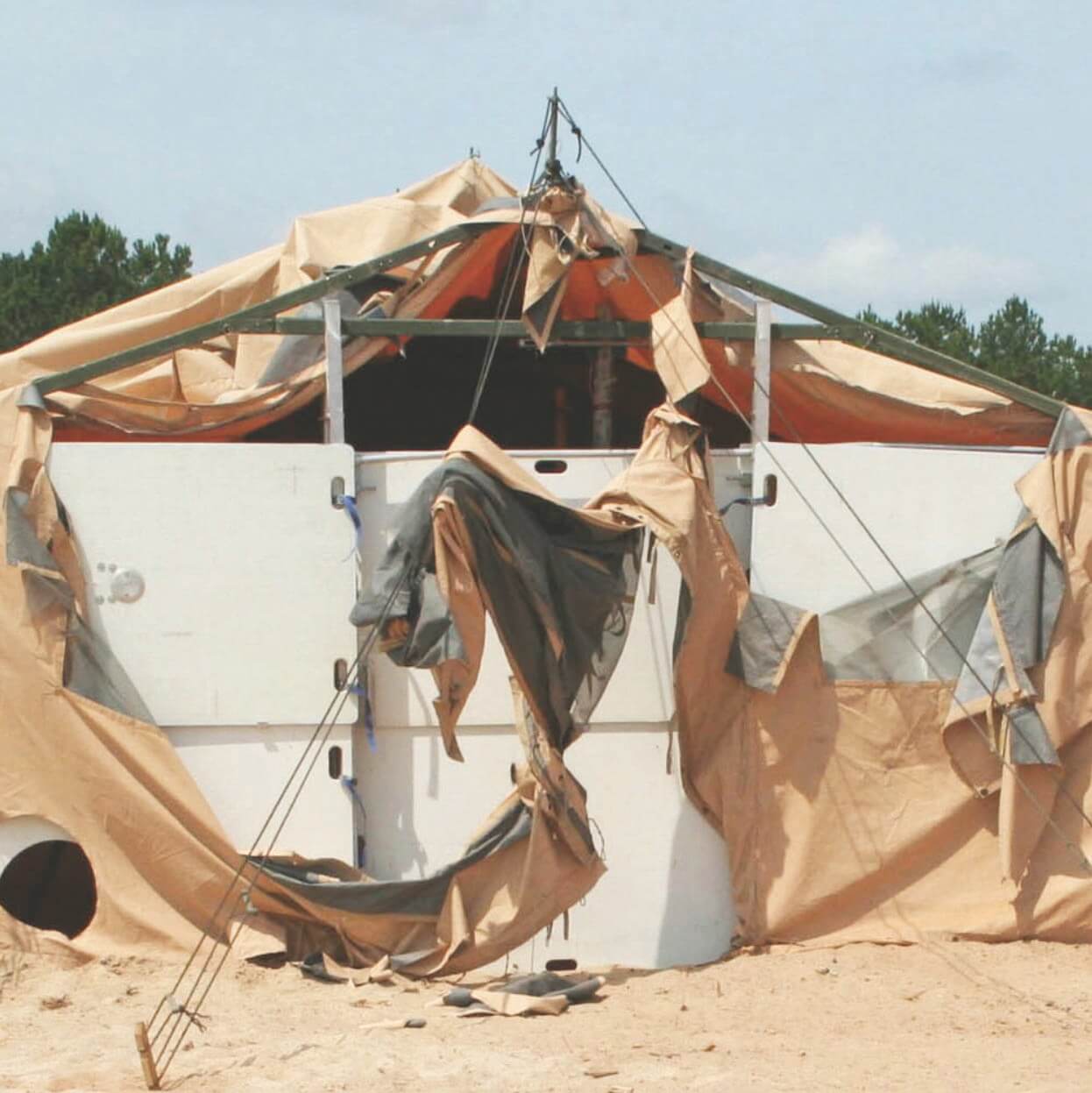 The University of Maine Advanced Structures and Composites Center has been awarded more than $3.2 million from the U.S. Army Natick Soldiers Systems Center to support development of technologies to protect troops in the field. The research builds on decades of R&D that led to the development of products like modular ballistic protection systems to protect military personnel in tents and inflatable arches for rapidly deployable shelters. The modular ballistic panel system is lightweight and rapidly deployable. Researchers are exploring the use of 3D printing to create shelters, and the development of new materials to increase protection and reduce detection, weight, production times and overall costs.
The University of Maine Advanced Structures and Composites Center has been awarded more than $3.2 million from the U.S. Army Natick Soldiers Systems Center to support development of technologies to protect troops in the field. The research builds on decades of R&D that led to the development of products like modular ballistic protection systems to protect military personnel in tents and inflatable arches for rapidly deployable shelters. The modular ballistic panel system is lightweight and rapidly deployable. Researchers are exploring the use of 3D printing to create shelters, and the development of new materials to increase protection and reduce detection, weight, production times and overall costs.
Altering Everest
 New findings from the most comprehensive sci-entific expedition to Mount Everest in history, pub-lished in November in the scientific journal One Earth, identify critical information about the Earth’s highest-mountain glaciers and the impacts they’re experiencing due to climate change.
New findings from the most comprehensive sci-entific expedition to Mount Everest in history, pub-lished in November in the scientific journal One Earth, identify critical information about the Earth’s highest-mountain glaciers and the impacts they’re experiencing due to climate change.
As part of the 2019 National Geographic and Rolex Perpetual Planet Everest Expedition, climate scientists, including those with the Climate Change Institute at the University of Maine, studied environmental changes, including in Everest’s “death zone,” to understand future impacts for life on Earth as global temperatures rise.
The new research fills a critical knowledge gap about the health and status of high-mountain environments, which are incredibly difficult to study due to the inhospitable environmental conditions.
Key findings include:
The highest-ever recorded sample of microplastics was found on the “Balcony” of Mount Everest at 8,440 meters, one of the last resting spots before reaching the summit. This microplastic is likely coming from the clothing and equipment worn by climbers, highlighting the impacts of humans on even the highest reaches of our planet.
Researchers surveyed nearly 80 glaciers around Mount Everest and found evidence of consistent glacial mass loss over the last 60 years and that glaciers are thinning, even at extreme altitudes above 6,000 meters. Using declassified spy satellites and a new highest-resolution data set, this is the most complete assessment of the status of the world’s highest glacier as a baseline for future research on its changes.
The research captures the first documented surge of a glacier (when it moves 10 to 100 times faster than it normally does) in the Mount Everest region, a phenomenon that can put people and communities at risk.
Seeing the light

The way leaves reflect light can illuminate the evolutionary history of seed plants, according to an international team of scientists led by a University of Maine researcher.
Plant reflectance spectra, or the light profile leaves reflect across different wavelengths, capture the change and diversification of seed plants as a result of evolution, according to Dudu Meireles, UMaine assistant professor of plant evolution and systematics.
Meireles and colleagues from the United States, Canada, Switzerland and England explored how spectra have evolved and diversified over the last 350 million years of plant evolution. They found that by measuring the light spectrum reflected by a leaf, they can identify the plant, learn about its chemistry and evolution, and pinpoint its place in the tree of life.
Spectra also can be used to “provide breakthrough assessments of leaf evolution and plant phylogenetic diversity at global scales,” the group wrote in its report for the study. Meireles says he hopes to eventually perform these measurements remotely using unmanned aerial vehicles, airplanes or satellites.
The research team conducted the study using a dataset of more than 16,000 leaf-level reflectance spectra.
The team’s findings were published as the cover article in the international journal New Phytologist.
The cover also features artwork titled “Biomimicry,” created with leaves and reclaimed wood by Adriana Cavalcanti of Orono, a UMaine intermedia MFA student.
#Selfies4Science
 Next time you put on a face mask before heading into the grocery store, Mollie Ruben would like you to snap a selfie and send it to her. Your #Selfie4Science will support COVID-19-related research.
Next time you put on a face mask before heading into the grocery store, Mollie Ruben would like you to snap a selfie and send it to her. Your #Selfie4Science will support COVID-19-related research.
The University of Maine assistant professor of psychology is interested in learning about people’s social perceptions and biases related to face masks in the pandemic. She’s building a database of people with and without face masks for a study that will have important implications for business, health care, education and interpersonal relationships.
“We are interested in capturing what biases may exist for particular stigmatized groups when wearing or not wearing a mask in the hopes of using this information to help reduce these potential biases from forming.” Graduate student Shelby Helwig
“COVID-19 has certainly changed many aspects of our everyday lives, but as a nonverbal communication researcher, the most stark change has been in our everyday social interactions,” says Ruben. “Not only are we interacting with people in different or fewer ways, but when we do interact with others in public spaces, it’s often and will continue to be behind a face mask.”
Nonverbal research suggests the eye and mouth regions are particularly important for communication purposes and impression formation, she says.
Ruben is a certified Facial Action Coding System (FACS) coder and an expert at analyzing facial expressions to assess emotions. At UMaine, she directs the Emotion, Pain, and Interpersonal Communication Lab, where she examines the expression and perception of nonverbal cues, and the role of nonverbal behavior in communication processes.
Healing potential
When the human body sustains injury, cells spring into action. New blood vessels emerge through a process called angiogenesis, and cells migrate in a coordinated campaign of healing. The ability to control these mechanisms has the potential to advance therapies ranging from cancer to wound treatment.
Polyphenols, a type of bioactive compound that naturally occurs in certain plants, have emerged as candidates for enhancing or slowing these processes. Lowbush blueberries like those grown in Down East Maine are among the richest known sources of polyphenols.
 At the University of Maine, scientists are working to identify exactly which of these wild blueberry polyphenols at what concentrations influence cell migration, angiogenesis and inflammation, and how they can be applied in clinical settings.
At the University of Maine, scientists are working to identify exactly which of these wild blueberry polyphenols at what concentrations influence cell migration, angiogenesis and inflammation, and how they can be applied in clinical settings.
A recent study led by Dorothy Klimis-Zacas, UMaine professor of clinical nutrition, found that different extracts and concentrations of two polyphenol fractions in wild blueberries, anthocyanins and phenolic acids, can influence blood vessel tube formation, gene expression and the synthesis of proteins — all of which are important factors in the tissue healing process.
Whyclimatechangematters.com
 Experts from the University of Maine, Harvard and Long Island universities, and the University of Maine School of Law have created a website with 10 talking points titled “Why Climate Change Matters to Your Security, Health & Wealth.” The site offers a one-stop shop for undecided voters and the general public to understand how climate change affects the most sensitive aspects of their everyday lives, and how efforts to reduce and reverse its effects represent the defining opportunity of our time. Paul Mayewski, Distinguished Maine Professor and director of the Climate Change Institute (CCI) at UMaine; Alexander More, associate professor of environmental health at LIU and research associate at Harvard and CCI; and Charles H. Norchi, the Benjamin Thompson Professor of Law at the University of Maine School of Law and director of the Center for Oceans and Coastal Law, framed the talking points and the research supporting them.
Experts from the University of Maine, Harvard and Long Island universities, and the University of Maine School of Law have created a website with 10 talking points titled “Why Climate Change Matters to Your Security, Health & Wealth.” The site offers a one-stop shop for undecided voters and the general public to understand how climate change affects the most sensitive aspects of their everyday lives, and how efforts to reduce and reverse its effects represent the defining opportunity of our time. Paul Mayewski, Distinguished Maine Professor and director of the Climate Change Institute (CCI) at UMaine; Alexander More, associate professor of environmental health at LIU and research associate at Harvard and CCI; and Charles H. Norchi, the Benjamin Thompson Professor of Law at the University of Maine School of Law and director of the Center for Oceans and Coastal Law, framed the talking points and the research supporting them.
Rural youth aspirations
 For middle and high school students in some forest-dependent rural communities in Maine and Oregon, a lack of money for education is the top barrier to pursuing the career they want, according to a survey of more than 2,000 youth by researchers at the University of Maine and Oregon State University.
For middle and high school students in some forest-dependent rural communities in Maine and Oregon, a lack of money for education is the top barrier to pursuing the career they want, according to a survey of more than 2,000 youth by researchers at the University of Maine and Oregon State University.
The teens surveyed in Piscataquis and northern Somerset counties in Maine, and in Coos County in Oregon were in agreement that training in hands-on skills, advice on education or college, and advice on jobs and applications would be most valuable in helping them realize their aspirations.
The Rural Youth Futures project survey results, published in a series of fact sheets and available on Digital Commons, provide schools and communities with insights into what the next generation of residents and workers value and need as their rural hometowns face economic, demographic and workforce changes, according to professors Mindy Crandall and Jessica Leahy.
When asked where they want to live and expect to live when they are 30 years old, the largest percentage of Maine students — 31% and 35%, respectively — said it would be in the same town, or nearby.
“Middle and high school students in both Maine and Oregon were able to clearly communicate what they would like to see as a future for their hometowns, and what they’d like to see for themselves — whether more school, a career, or where they live as adults,” says Leahy, UMaine professor of human dimensions of natural resources.
In 2017, Crandall and Leahy, then both faculty members in the UMaine School of Forest Resources, launched the three-year study, “Youth aspirations and labor market transitions in rural communities,” funded by a more than $458,000 USDA award. Crandall is now an assistant professor in the College of Forestry at Oregon State University.
The project looked at economic restructuring, community characteristics and young people’s perceptions of local labor markets in traditionally forest-dependent rural communities in Maine and Oregon. The survey included questions designed to learn how teens felt about their local community, their school and their economy. It also explored rural youths’ perceptions and aspirations, with a goal of better understanding youth decisions about their human capital investments, and the potential impact their choices may have on rural community persistence in the future.
New Aquaculture Experiment Station
 To address the issues facing the aquaculture industry in Maine and the nation, an Aquaculture Experiment Station has been established by the University of Maine Aquaculture Research Institute (ARI), in partnership with the U.S. Department of Agriculture Agricultural Research Service (ARS) and Auburn University. This cooperative agreement is a commitment to an ongoing conversation between researchers and the aquaculture industry to increase sustainable production and industry resilience.
To address the issues facing the aquaculture industry in Maine and the nation, an Aquaculture Experiment Station has been established by the University of Maine Aquaculture Research Institute (ARI), in partnership with the U.S. Department of Agriculture Agricultural Research Service (ARS) and Auburn University. This cooperative agreement is a commitment to an ongoing conversation between researchers and the aquaculture industry to increase sustainable production and industry resilience.
The cooperative research and development agreement, eligible for renewal every five years, is funded by $950,000 from USDA ARS for the first year, and $750,000 annually thereafter. The Aquaculture Experiment Station will harness the expertise of ARI-affiliated faculty in Orono and at UMaine’s Darling Marine Center in Walpole, and ARS researchers based on the Orono campus and at the National Marine Cold Water Marine Aquaculture Center in Franklin. The agreement also includes ARS shellfish researchers at the University of Rhode Island.
ARI faculty leads Deborah Bouchard, Damian Brady and Paul Rawson work at a national level in aquatic animal health, shellfish genetics and intelligent farm siting. As researchers in the Aquaculture Experiment Station, the three UMaine experts will expand their work to address USDA ARS priorities.
The experiment station will allow researchers to provide rapid response to the shellfish industry in a farm and hatchery setting. New research initiatives, focused on genetic improvement of North American Atlantic salmon and the Eastern oyster for aquaculture production, advance the goals of localized selective breeding strategies that improve performance for economically important traits, including growth and disease resistance.
Gene discovery
Jared Talbot is part of a 32-member inter-national research team that identified a gene that, when altered, can cause bent fingers and toes, clubfoot, scoliosis and short stature.
The team discovered that partial loss of the protein coding gene MYLPF (myosin light chain, phosphorylatable, fast skeletal muscle) results in a disorder called distal arthrogryposis (DA) that’s present at birth.
Talbot, an assistant professor in the University of Maine School of Biology and Ecology, is the study’s second author. He contributed equally with Jessica Chong, the first author and an assistant professor of human genetics at the University of Washington.
The discovery has several exciting implications.
“Before a disease can be effectively treated, its cause needs to be understood,” says Talbot. “Right now, DA is treated through surgery, which often has to be repeated several times over a lifetime. By understanding the disease better, we may be able to discover longer-lasting and less-invasive ways to treat it.”
The breakthrough adds to scientists’ knowledge about how prenatal muscle formation affects health throughout a lifetime, he says.
American Journal of Human Genetics published the team’s findings.
Outdoor resources for teachers
Students in the University of Maine outdoor leadership program have created a website that K–12 teachers can use to plan outdoor lessons and activities. The site features videos, quizzes, slideshows and other resources produced by UMaine students on topics ranging from mountain biking and wilderness survival to outdoor ethics issues, such as planning trips that leave no trace.
The resources were developed in the Advanced Methods of Instructing Outdoor Activities course during the fall 2019 and 2020 semesters. Instructor Lauren Jacobs, UMaine lecturer of outdoor leadership, says the idea is for students in the outdoor leadership program to add to and build on the resources.
Shifting shorelines
Every year since 1982, Joseph Kelley captured photos of the fastest deteriorating portion of Maine’s coast, located in Camp Ellis, for use in his work as a state marine geologist, and research and teaching at the University of Maine.
The public now has the opportunity to view decades of geologic transformation captured in the images taken of the Saco-area shoreline, as well as thousands of others depicting dramatic changes in Maine’s coastal vistas.
The professor emeritus partnered with the Maine Geological Survey to archive 8,000 of his landscape images, most of which depict the coast, in an online database on the state agency’s website. Users will have access to photos capturing vistas at particular moments in history and time series collections featuring the shifting geology of certain places over time. The U.S. Geological Survey provided more than $30,000 in funding for the archiving project.
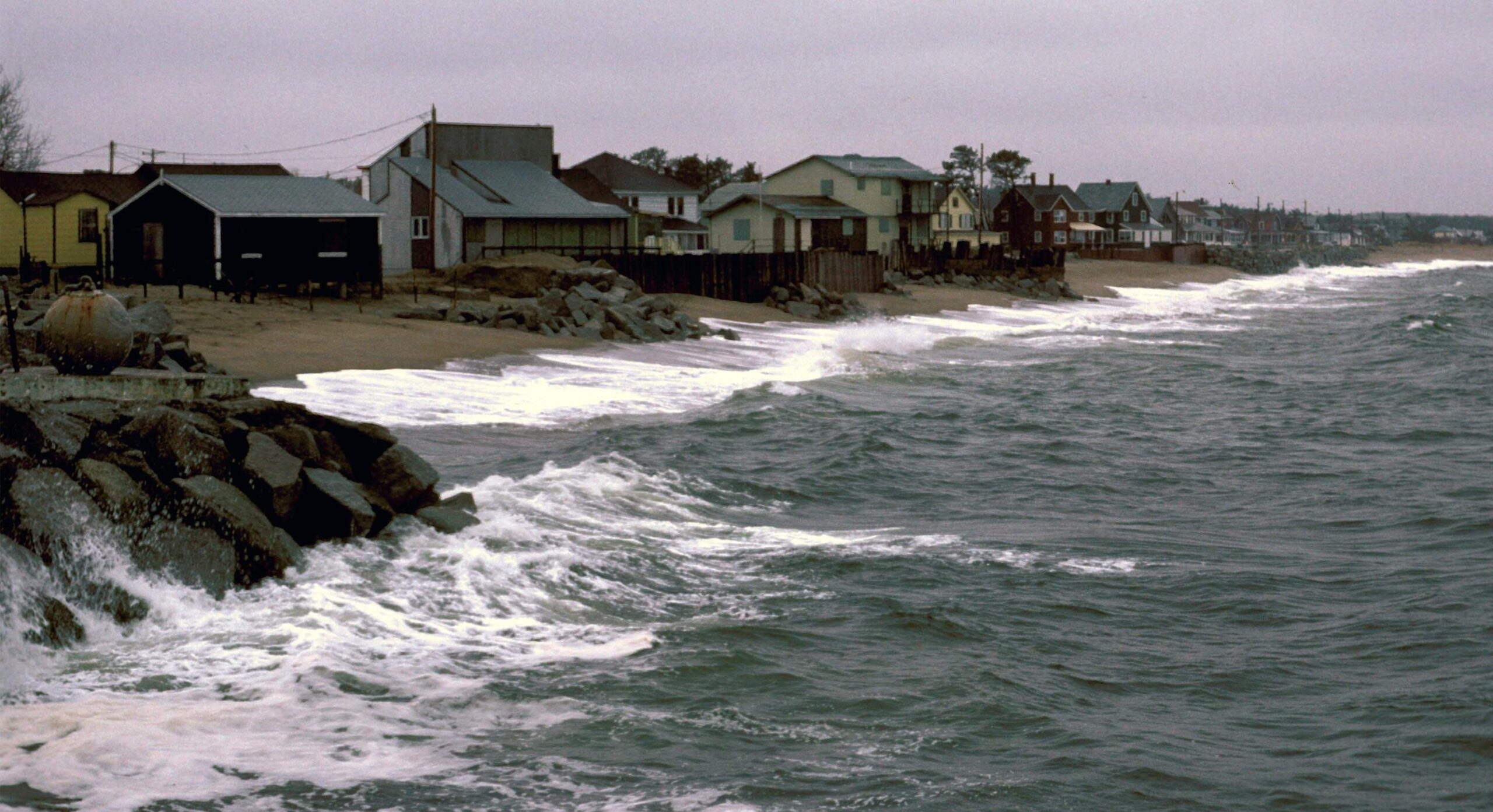
The coast of Maine always changes, and every photograph of it captures an iteration no one will witness again, says Kelley, who retired from UMaine Sept. 1.
“On the coast, every photo is a ‘before,’” he says.
Research Kelley conducted in the last 38 years, including studies of the response of developed and pristine shorelines to sea level change, provided ample opportunities to take photographs. His collection features photos taken from the ground and some from the air highlighting the geology of locations such as Silsby Plain in Aurora, Jasper Beach in Machiasport and Sand Beach in Acadia National Park.
Fiddlehead findings
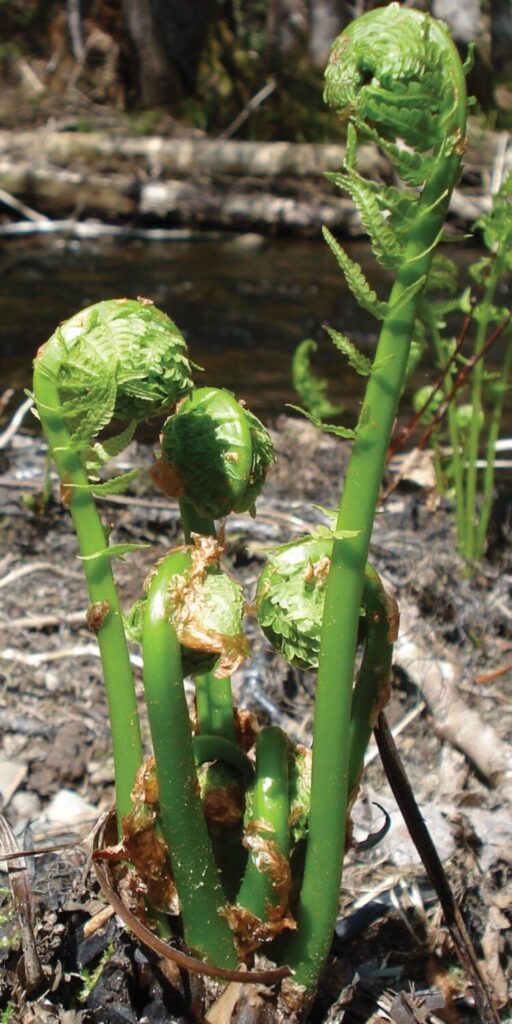
Fiddleheads, a traditional springtime delicacy in New England and Eastern Canada, can decline significantly over time if harvesters pluck too many from the same plants in a season, according to a new four-year study conducted by a University of Maine Cooperative Extension expert.
Fern crowns with all the fiddleheads removed in a single harvest suffered significant decline in growth in the subsequent years, and in some cases were killed outright, according to David Fuller, UMaine Extension agricultural and nontimber forest products professional.
A more sustainable harvest removed 50% of the fiddleheads in a one-time picking, but also resulted in reduced frond production in subsequent years.
“These findings suggest that fewer than half of the fiddleheads from a given plant could be harvested and be sustainable with no follow-up harvest that year,” Fuller says. “Plants whose fiddleheads have already been harvested by other harvesters that spring should be left alone.”
Portal to Franco American history
A University of Maine initiative to create a first-ever bilingual portal to Franco American history records from archives in the United States and Canada received a nearly $60,000 grant from the National Endowment for the Humanities.
UMaine Franco American Programs, which is spearheading the Franco American Portal, also was awarded $10,000 from the Maine Bicentennial Commission for a similar project titled “Where Were You.” That effort involves developing an online public history, genealogy and map of Franco American populations in Maine.

Researchers of history and culture of the French Canadian and Acadian diaspora of New England sometimes struggle to find primary sources when pertinent records are not cataloged with relevant identifiers, or are otherwise difficult to access, says Susan Pinette, director of UMaine Franco American Programs and professor of modern languages. The online, bilingual Franco American Portal will make these Franco American records more visible, searchable and accessible to researchers, educators, students, genealogists and the public.
The University of Southern Maine Franco-American Collection; University of Maine at Fort Kent Acadian Archives; Assumption College’s French Institute, Worcester, Massachusetts; and Saint Anselm College Msgr. Wilfrid H. Paradis Archives and Special Collections, Manchester, New Hampshire, joined UMaine’s Franco American Programs in developing the online gateway. Jacob Albert, project manager for UMaine’s Franco American Programs, guides portal development, and Pinette oversees it.
The website will provide access to books, letters and other correspondence, scrapbooks, family and business records, photographs and other media depicting Franco American history, culture and people, all curated by the portal project team. In addition to connecting users with records from their own universities’ collections, the team behind developing the portal is seeking to partner with other institutions across the U.S. and Canada.
UMaine national terrorism
expert tapped
A University of Maine researcher who is a national expert on terrorism research is part of the new National Counterterrorism Innovation, Technology and Education (NCITE) Center of Excellence at the University of Nebraska at Omaha.
The center is funded by a 10-year, $36 million grant from the U.S. Department of Homeland Security Science and Technology Office of University Programs.
The University of Nebraska at Omaha leads a national consortium of industry partners and 17 universities selected by the Department of Homeland Security.
Karyn Sporer, a UMaine assistant professor of sociology, is one of 63 researchers in the consortium. She serves as a principal investigator for counterterrorism and terrorism prevention research. Sporer received a Ph.D. in criminology and criminal justice from the University of Nebraska at Omaha, and continues to collaborate with a research team there. The team of scholars and faculty from diverse disciplines, including business, industrial/organizational psychology, and information science and technology, is examining the organizational structure of and use of innovation (e.g., malevolent creativity, including innovative weapons, recruitment tactics, etc.) by violent terrorist organizations.
Sporer’s research project as part of the new center will focus on the role of families of violent Islamic extremists in reporting suspicious behavior. According to Sporer, family members of violent extremists play an important part in preventing terrorism, whether it be with deradicalization and disengagement, or by alerting authorities when concerned for the safety of their loved one(s) and/or others.
Fitness trackers in the lobster
supply chain
 Miniature fitness trackers for lobsters and devices to monitor the quality of their shipping conditions are being prototyped as part of an initiative to reduce stress points and improve survival in the lobster supply chain for the Maine lobster industry.
Miniature fitness trackers for lobsters and devices to monitor the quality of their shipping conditions are being prototyped as part of an initiative to reduce stress points and improve survival in the lobster supply chain for the Maine lobster industry.
The University of Maine Lobster Institute leads the initiative in collaboration with lobster industry partners and scientific collaborators at Saint Joseph’s College and Wells National Estuarine Research Reserve. This effort to improve practices to reduce mortality throughout the lobster supply chain was one of 30 projects nationwide to receive funding earlier this year from the National Oceanographic and Atmospheric Administration Saltonstall-Kennedy Program. Of the eight funded projects in the Atlantic region, it is the only one focused on the American lobster.
“Maine’s lobster industry asked the institute to help quantify and mitigate stress points in the lobster supply chain that reduce survival and profitability,” says Lobster Institute director Rick Wahle, who is based at UMaine’s Darling Marine Center. “The industry calls it ‘shrink’ — the mortality lobsters experience as they change hands from capture to kitchen. It’s been a long-standing, contentious issue that is heating up, both literally and figuratively, in a changing climate and competitive world market.”
As part of the two-year project funded at more than $299,000, miniature sensory devices — crustacean heart and activity trackers (C-HAT, pronounced sea-hat) — are being prototyped. Comparable to a human fitness tracker, the noninvasive device strapped on a lobster is designed to monitor heart rate and movement as the crustacean passes from trap to on-board live tank to live storage crate to truck to wholesaler or processor.
A separate sensor-equipped device called the MockLobster also will travel along with crated lobsters to log environmental conditions experienced, including temperature, light and dissolved oxygen.
Seabird response
The Falkland Islands are a South Atlantic refuge for some of the world’s most important seabird species, including five species of penguins, Great Shearwaters and White-chinned Petrels. In recent years, their breeding grounds in the coastal tussac (Poa flabellata) grasslands have come under increasing pressure from sheep grazing and erosion. And unlike other regions of the globe, there has been no long-term monitoring of the responses of these burrowing and ground nesting seabirds to climate change.
A 14,000-year paleoecological reconstruction of the sub-Antarctic islands led by University of Maine researchers has found that seabird establishment occurred during a period of regional cooling 5,000 years ago. Their populations, in turn, shifted the Falkland Islands ecosystems through the deposit of high concentrations of guano that helped nourish tussac, produce peat and increase incidence of fire.
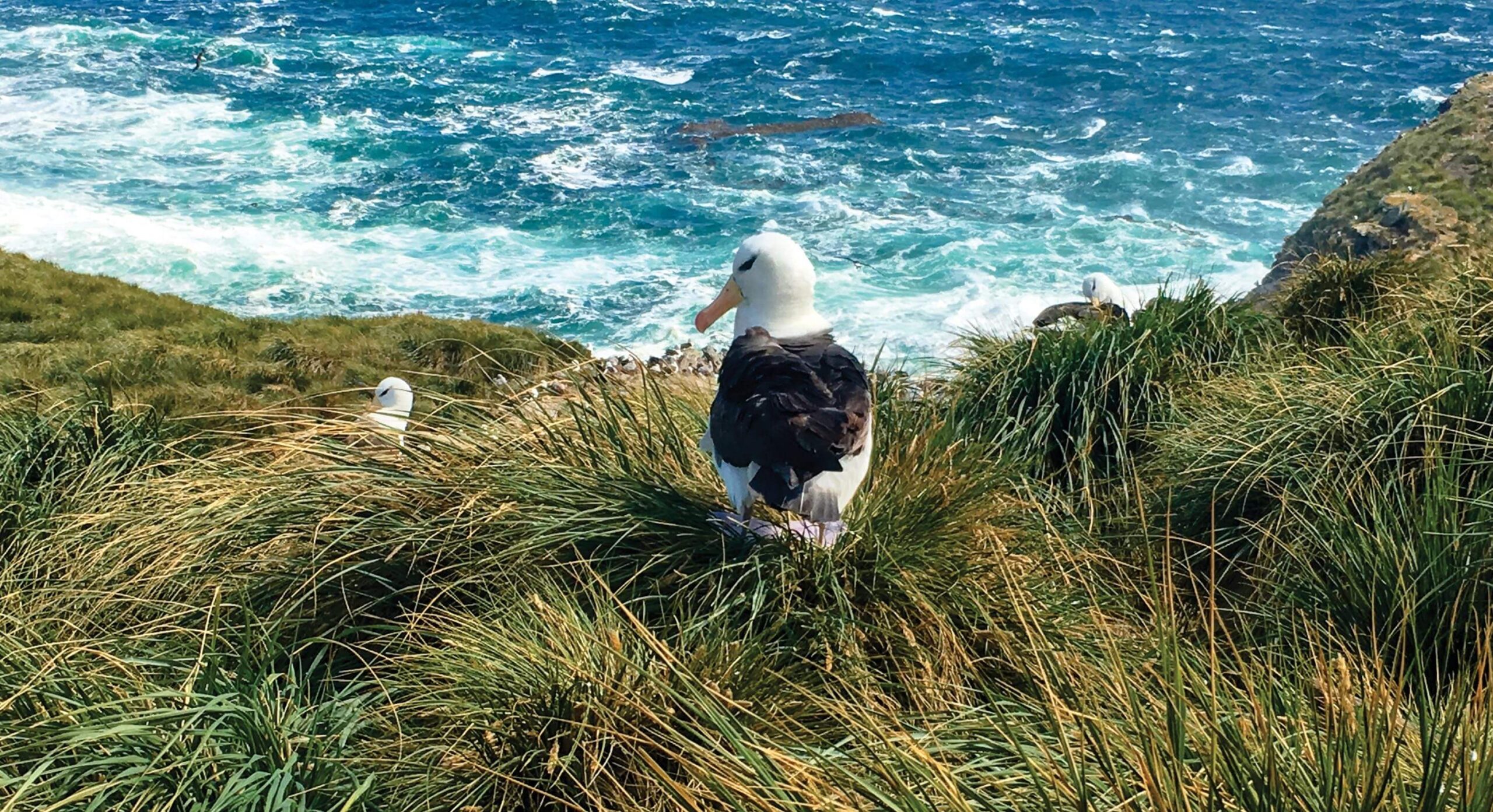
This terrestrial-marine link is critical to the islands’ grasslands conservation efforts going forward, says Dulcinea Groff, who led the research as a UMaine Ph.D. student in ecology and environmental sciences, and part of a National Science Foundation-funded Interdisciplinary Graduate Education Research Traineeship in Adaptation to Abrupt Climate Change. The connection of nutrients originating in the marine ecosystem that are transferred to the terrestrial ecosystem enrich the islands’ nutrient-poor soil, thereby making the Falkland Islands sensitive to changes in climate and land use.
The terrestrial-marine linkage was the focus of Groff’s dissertation in 2018. Groff conducted the research in the Falkland Islands during expeditions in 2014 and 2016 led by Jacquelyn Gill, a UMaine associate professor of paleoecology and plant ecology. Groff is now a postdoctoral research scientist at the University of Wyoming.
Microfluidic channels
Development of a new, low-cost microfluidic water purification system by researchers at the University of Maine and Harvard University’s Wyss Institute for Biologically Inspired Engineering has been funded by the National Science Foundation.
“Microfluidics exemplifies the nanoscale texturing capability of Sappi’s Ultracast paper manufacturing process.” Microfluidics exemplifies the nanoscale texturing capability of Sappi’s Ultracast paper manufacturing process.” Nicholas Yardy, director of release technology, Sappi North America
The initiative, led by Caitlin Howell, UMaine assistant professor of biomedical engineering, focuses on a method of quickly prototyping a portable pulsed-electric-field sterilization system for membrane filters with a direct route to mass manufacture on industrial-scale equipment. NSF awarded the project $154,566 in EPSCoR Research Infrastructure Improvement funding.
Membrane filtration to purify drinking water can be expensive as the filters can become blocked with debris and need to be replaced. One solution, invented by researchers Richard Novak and Elizabeth Calamari, as well as professor Donald Ingber of the Wyss Institute, is AquaPulse, an off-grid, portable water purification apparatus that uses a pulsed electric field to kill bacteria, parasites and viruses. The system uses a series of microfluidic channels to expose the water to the electric field, removing the need for filters.
However, making these devices widely available at a low cost requires a method to mass-manufacture the microfluidic channel system. Working with Novak, Adama Sesay and Ingber, Howell will apply a new method based on 3D printing direct to industrial roll-to-roll casting, which she recently developed in collaboration with Sappi North America for fast prototyping of scalable microfluidic systems using papermaking equipment. PLOS ONE published a journal article about the technology on Dec. 28.
Howell and the Wyss researchers will focus on a broad range of microfluidic fabrication, assembly and analysis techniques needed to apply the process to water purification.
In addition, Howell and University of Massachusetts Amherst chemical engineer Jessica Schiffman received a more than $225,000 NSF EAGER — early-concept grants for exploratory research — award for development of a bioengineered membrane for the detection and analysis of airborne coronavirus droplets. Collaborating on the project is UMaine virologist Melissa Maginnis.
